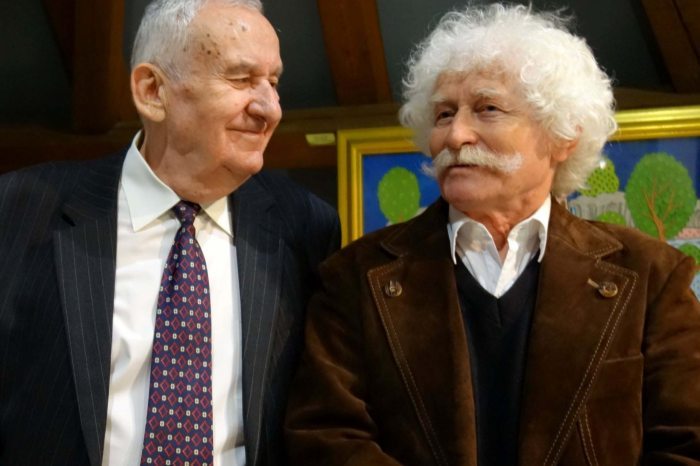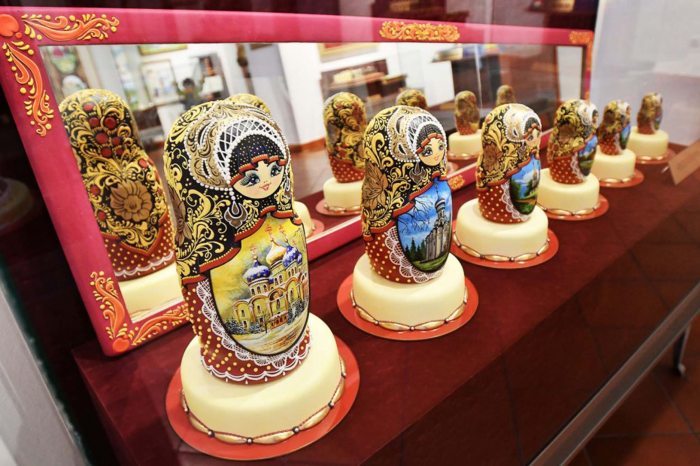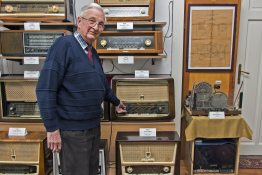Sugar bell, sugar stamp, sugar room – Marzipan Land, the empire of the Oscar-winning Lajos Kopcsik
It’s not only the taste of sweets that you can enjoy, but also the sight of them. This is especially true when someone uses sugar to create an icon, a mosaic, a reproduction of a painting, a bell, or an entire baroque room. Master confectioner Lajos Kopcsik has created his own empire, the Marcipánia (‘Marzipanland’), in Eger. The master passed away in June taking the secrets of his trade with him but his creations remained. We remember Lajos Kopcsik, Oscar and Venesz Prize winner, Guinness World Record holder, and world and Olympic champion with his friend and fellow artist, painter, and graphic artist István Herczeg.

“Hiring a decent boy for apprentice ”
Kopcsik Lajos’s father was a miner but played the accordion beautifully and one of his friends played the violin and the two of them often played together. These childhood memories made music a part of Lajos’s life. Whenever he was working on a piece of art, he always listened to the music of Bach, Vivaldi or Mozart. Besides music, he was very fond of visual arts. ”Both of my hobbies help me in my work: loving music fills my heart and soul with joy, and loving visual arts helps my eyesight in my work” – he said.
One day this weak, and ailing boy was walking on the Main Street of his hometown, Sajószentpéter with his mother when they saw a note in the store window of Pál Schmida master confectioner saying: “Hiring decent boy for apprentice”.
His mother told him right away to apply saying he could even get a bit stronger from eating lots of cakes. This is how at the age of 14 he started his career in the trade and fell in love with it. He was proud of his long white apron and he watched in awe how Pali bácsi filled 8-10 cakes simultaneously with cream. Not long afterwards however the door of the store got walled up and the master’s business license was withdrawn, and the apprentice boy had to go and work for the Borsod Vendéglátó Vállalat (‘Borsod Catering Company’) of which he later became manager. He did his internship in the capital, where he worked with Mátyás Szamos, among others. Since the age of 19, he has participated in national and international professional competitions, where his work has always been awarded a gold medal. At the age of 20, he married Margit Bencs, who also worked as a confectioner, and became his loyal companion and his stable background that allowed his talent to flourish.
Matryoshka dolls with onion-domed temples on their bodies
In 1988, he won a gold medal and an Oscar Award for confectionary as a member of the Hungarian national team at the Frankfurt Baking Olympics. In the same year, he moved to Eger, where he managed, among other things, the Kopcsik confectionery. Here he created vibrant cultural life with exhibitions and artists invited for coffee. After many years, it was here that through work he met István Herczeg, a painter and graphic artist who was from the same region of Hungary, too. The creative confectioner turned to pastry artistry when he was a teacher at the Vocational Training School for Catering in Eger. He was asked to chair the jury of a professional competition, where he took ten pieces of his work to be exhibited.
Immediately he was entered into the Berlin Olympics, where he won ten gold medals at one go and this got him into the Guinness Book of World Records.
"An entrepreneur who had opened the Eszterházy confectionery in Moscow, recognised the opportunity and in 1996 gave us the assignment to create a pastry artistry decoration," recalls the artist friend. - "We started thinking about what we could make out of sugar. We decided on the matryoshka doll, and I painted onion-domed Russian churches on the dolls' bodies." Also a world record was the three-and-a-half square metre sugar mural in the Offi House in Eger, designed and painted by István Herczeg in the style of miniatures found in the Topkapi Serai in Istanbul, in memory of the Turkish times in Eger. "We also invented a technique that made the artwork look like an icon. The night before the solution was born, we drank two bottles of champagne." And 15 years of working together, brainstorming and humour passed like this.
Hard sugar dough, without almonds
The tragacanth, a sugar paste made of gelatine and icing sugar, became the basic ingredient, which the master developed further. As a decorative glaze, he used a mixture of egg white and sugar flour. The marzipan had to be left out because the high fat content of the almonds in the mixture makes it turn rancid. The sugar dough when dry is as hard as porcelain. It can be polished, which was the job of Sándor Sebők, the world's only master sugar polisher. Then came the artistic work of István Herczeg, who painted with tempera paint or precisely sketched the design. "I dealt with the three-dimensional pieces by painting, but I drew the flat shapes precisely. We put the colouring material in cellophane, like what you do when you decorate gingerbread, and whatever I designed, Lajos would sprinkle it on," says the graphic artist.
Dried, hard sugar dough is fragile, so for competitions, usually, two of each pieces of art were made.
"Lajos used to mould the sugar on styrofoam because raw sugar alone would not have held. The inner styrofoam at least held the mould until it dried. This is how the bell was made, for example."
”Pistike, what shall we do?”
With István Herczeg, we walk through the rooms of Marcipánia (‘Marzipan Land’), the former bell foundry, although the name can be a bit misleading, as marzipan had to be left out of the works of art that were meant to be permanent. István tells a story for each piece and chuckles good-naturedly at the memories he recalls. The brainstorming often started with a question: "Pistike, what shall we do?" (“Pistike” is a nickname for István) This is how the world's largest sugar stamp, the sugar version of the special stamp for Children's Day designed by artist friend János Kass, was created. Among the 120 objects, we find a two-metre-high wine bottle, the Minaret, a Vasarely reproduction, a Monet painting for the exhibition of the Museum of Fine Arts and Van Gogh's famous sunflowers, with every brushstroke precisely captured.
The pair was also inspired by the memory of Gárdonyi: of sugar dough, they created his chair, on which he sat to write the Eger Stars, and a portrait of him with a pipe.
"We feel a personal attachment to each piece," says the co-artist. - "Lajos's grandson loved the cartoon figure, the Little Mole, so we made one, as we made others, like Vuk, Nils Holgersson and Lúdas Matyi. In the latter, I also included a real cep, next to the fly agaric that is common in storybooks." A chess set was also made at the request of a chess player.
The more absurd the idea, the more attractive
"My wife once suggested that we make a funnel gramophone. Lajos thought it was an absurd idea, but in the end, it haunted him and he made two pieces: one for Moscow and one for Eger. A sculptor friend of mine, Sándor Sebestyén, sculpted a small bronze statue, the Trout Quintet, using the wax-casting bronze technique. We used this idea to create a record composition with five swimming trout. I have also hidden personal thoughts on it, such as "conducted by Lajos Kopcsik". People often don't even notice this kind of humour."
"Pistike, let's do a folk art thing!" - the master confectioner once asked. István designed a palette of Hungary's most famous ethnographic regions. "Both of us had an educational intention to try to steer people in the right direction with our work."
"There was only one suggestion to which Lajos Kopcsik at first not only said no but asked me directly: "Pistike, do you want to kill me?" Each frame of the Ravenna mosaic had to be coloured separately, in shades. For three years, he was torn before he decided to do it. It was a serious professional challenge."
Baroque sugar room, guarded by a sugar dog
The Kopcsik Marcipánia opened in 2005, followed by three years of work, the master's long cherished dream, the Baroque room.
Everything here is made of sugar, except the mirror and the window glass. The floor, the wallpaper, the curtains, the chandelier, the impressive stove, the sofa, the tabla e with fruit, the violin with a bow.
The portraits of his grandchildren’s, as well as his wife’s and his own are on the wall. István also tells us how lifelike every inch of the Baroque room looks: “For the bone in front of the sugar dog that guards the room, we took a sample from the butcher, and when it was finished, I looked at Lajos to see if he was looking my way and then smelled the bone to determine which was the real thing and which was the sugar.” One day the violin bow bent a bit, and that's when they discovered that the building had got a leak. The main enemy of sugar is moisture, so it took months of struggle to save the baroque wonder.
On one occasion, a Russian visitor had a craving for the showy sugar pastry and took a curious bite of the umbrella holder. Fortunately, it was not part of the exhibit, it was made of real metal. "Lajos was always cheerful and we had a lot of fun together, and in our circle of friends and acquaintances. He welcomed everyone. He also played a lot with his two grandchildren, and when they grew up he missed these moments of joy," says his friend.
Sometimes he even forgot to eat...
They created a travelling exhibition with István Herczeg, which was last exhibited on the occasion of the master's 80th birthday.
Lajos Kopcsik lived for his work and family.
Artwork brought him a lot of joy, although he hardly ever took a weekend or a break, sometimes forgetting to eat while he worked. When this way of life came to an end because of the lack of a workshop, the confectioner's soul was shattered. His loneliness as an artist was made even more profound at the time of the Covid pandemic. The artist, who left the mark of his hand and talent not only in Eger but also in Russia, Sweden and the USA, may now be moulding angels up there, to the live music of his favourites. Let us hope that the unique work of art created with István Herczeg will survive intact for a long time to the joy of the whole world and the pride of Hungarians.
Resourses:
- http://www.kopcsikmarcipania.hu/kopcsik-lajos/
- https://receptletoltes.hu/arch%C3%ADvum/11932?pdf=11932
- http://www.egri-magazin.hu/az-egesz-eletem-a-cukraszatrol-szolt-el-sem-tudtam-volna-mast-kepzelni/









